Ergonomic Considerations
in Dairy Work
Explanation of Work Tasks
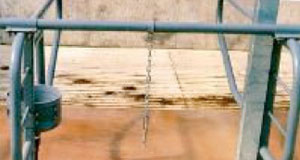
Tie Stall-requires more flexion, more knee bending (19% of time) and squatting (11% of time)

Free Stall-less flexion
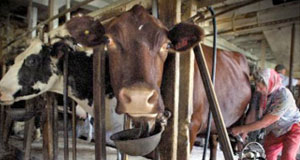
Stanchions - requires more flexion, more squatting - 24% of the time
Milking: Parlor milking-Cows are milked in a raised area eliminating the need to bend or squat. Workers wash the teats with sprayers hanging from the ceiling, removing milk from the udder prior to milking and attaching the milking unit (around 6 lbs.). Pipeline milking– milking units are trans- ported to the animals. Equipment is either car- ried by the milker or on a cart. The milking unit weighs about 8-10 lbs. Involves more overhead work and work at shoulder level.
Feeding Cows/Calves: Ergonomic risks in this task are governed by the degree of mechanization. The process can be very labor intensive or not depending on the automation of techniques. Climbing into the silo or mow and picking up bags of feed 50-100 lbs may be re- quired. A shovel full of feed can weigh up to 33 lbs. Calves are usually fed milk from a nipple or bucket (bottles weighing around 4 lbs, buckets up to 35 lbs). Feeding requires sustained forward bending/reaching, gripping of bucket, heavy lifting and carrying materials long distances.
Cleaning Barn: Cleaning grates and stalls involves pulling or pushing a shovel across the stall surface and depositing waste into the gutter. Stalls are usually swept, as well and the task involves frequent twisting, bending and sustained forward reach. After stalls are cleared of debris bedding is placed on the floor of the stall. This requires retrieval of bales and in- volves repetitive lifting and bending, ladder climbing and carrying 40-50 lbs over uneven or slippery surfaces. Milking units and equipment also needs to be washed and involves sustained forward bending, repetitive lifting, sometimes heavy lifting and a sustained reach.
Results from NYCAMH PATH* analysis.
A breakdown of time spent in awkward postures:
Percentages presented indicate the portion of time the worker spends in each posture. 21% of milking time is spent bearing loads of 5-10 lbs and 8% of time bearing loads of 10-30 lbs.
Milking Cows – involves more at risk postures than feeding and barn cleaning.
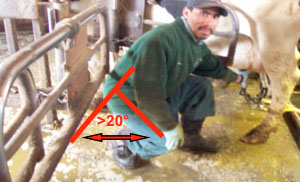
30% of time in moderate hip flexion- upper leg bent more than 20°
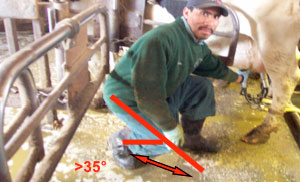
13% of time, knee in bent position- at least one knee bent 35° or more

12% of time knee in squatting position-angle of both knees at least 90°
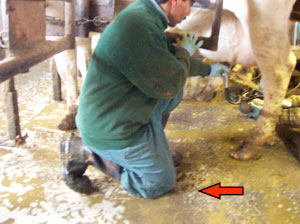
7% of time kneeling-at least one knee touching ground
Other tasks such as cleaning the barn and feeding cows involve mostly neutral postures. However these tasks do involve load bearing:
Barn cleaning
- loads of 5-10 lbs 37% of time
- 10-30 lbs 13% of time
- 30-75 lbs 9% of time
Feeding cows
- loads of 5-10 lbs 13% of time
- loads of 10-30 lbs 13% of time
- loads of 30-75 lbs 7% of time
*Information gathered using PATH analysis in orchards. PATH is an acronym that stands for Posture-Activities-Tools-Handling and this method of analysis allows for the quantification of ergonomic risk factors in work tasks.